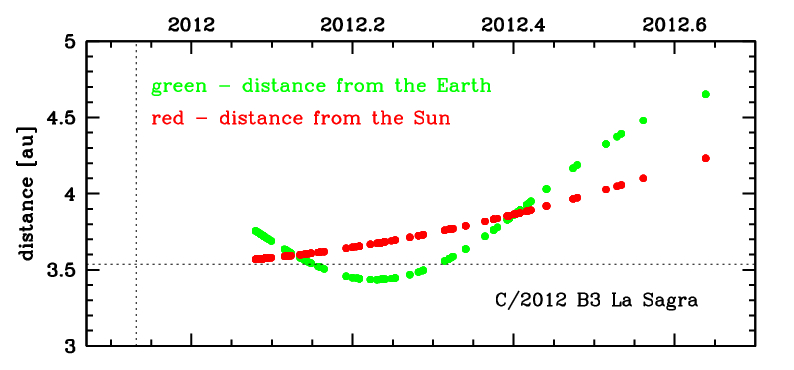C/2012 B3 La Sagra
more info
Comet C/2012 B3 was discovered on 29 January 2012, that is about two months after perihelion passage, and next observed almost continuously 0.56 yr in a range of heliocentric distances from 3.57 au to 4.23 au.
Comet had its closest approach to the Earth on 24 March 2012 (3.436 au, almost two months after discovery, see figure).
This Oort spike comet suffers small planetary perturbations during its passage through the planetary system that lead to a more tight future orbit (see future barycentric orbit).
See also Królikowska and Dybczyński 2017.
Comet had its closest approach to the Earth on 24 March 2012 (3.436 au, almost two months after discovery, see figure).
This Oort spike comet suffers small planetary perturbations during its passage through the planetary system that lead to a more tight future orbit (see future barycentric orbit).
See also Królikowska and Dybczyński 2017.
| solution description | ||
|---|---|---|
| number of observations | 301 | |
| data interval | 2012 01 29 – 2012 08 21 | |
| data type | observed only after perihelion (POST) | |
| data arc selection | entire data set (STD) | |
| range of heliocentric distances | 3.57 au – 4.23au | |
| detectability of NG effects in the comet's motion | NG effects not determinable | |
| type of model of motion | GR - gravitational orbit | |
| data weighting | YES | |
| number of residuals | 589 | |
| RMS [arcseconds] | 0.38 | |
| orbit quality class | 1b | |
| orbital elements (heliocentric ecliptic J2000) | ||
|---|---|---|
| Epoch | 2011 12 25 | |
| perihelion date | 2011 12 06.85647186 | ± 0.00150061 |
| perihelion distance [au] | 3.53656667 | ± 0.00000712 |
| eccentricity | 1.00142339 | ± 0.00001561 |
| argument of perihelion [°] | 50.736713 | ± 0.000322 |
| ascending node [°] | 252.998269 | ± 0.000064 |
| inclination [°] | 106.932238 | ± 0.000012 |
| reciprocal semi-major axis [10-6 au-1] | -402.48 | ± 4.41 |
